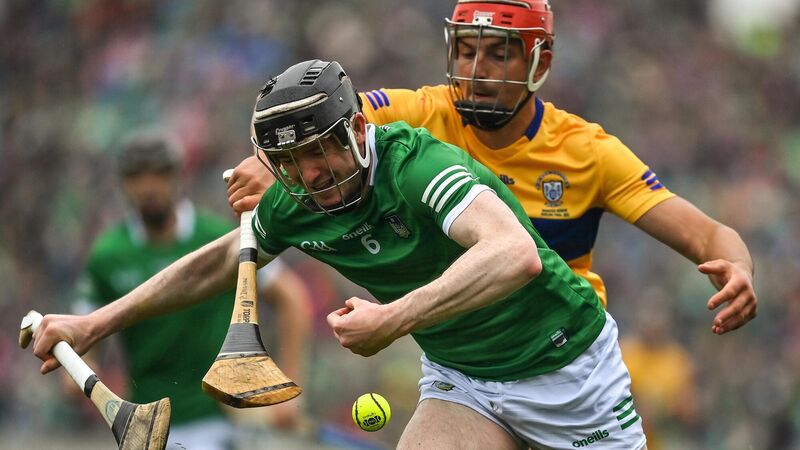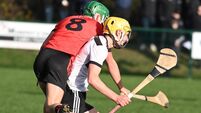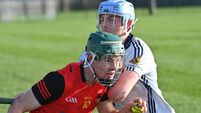The fast and the furious: Munster final numbers show a standard and level hurling has never witnessed before

High-octane everything: Declan Hannon of Limerick is tackled by Peter Duggan of Clare during the Munster GAA Hurling Senior Championship Final match between Limerick and Clare at FBD Semple Stadium in Thurles, Tipperary. Pic: Brendan Moran/Sportsfile
The opening minute of the recent Munster final was more akin to an opening seconds of the Running of the Bulls in Pamplona than a hurling match. Bodies were being fired everywhere amidst the chaos.
Players were being mown-down. All hell was breaking loose. Everywhere.
After the throw-in, Cathal O’Neill managed to smuggle the ball into his hand but he was immediately surrounded by Peter Duggan, Tony Kelly, Ryan Taylor and Cathal Malone before Duggan eventually forced the turnover.
After Malone scooped up the loose sliotar, he was forced back by Seamus Flanagan, who kicked the ball forward to Darragh O’Donovan. He tried to cross the ball but his pass was blocked by Rory Hayes. When O’Donovan got off the pass at his second attempt, Aaron Gillane was hounded by Conor Cleary and Malone was back hunting the loose ball.
Malone was hit by Will O’Donoghue and as Cleary tried to snaffle the ball, it popped up in the air like a greasy bar of soap. O’Neill and Shane O’Donnell desperately tried to get the ball into their hand but they couldn’t. When John Conlon finally did, he was ensnared by another gang of Limerick hunters and was fouled. Phew.
During those opening 39 seconds, the players only had possession of the sliotar for a combined total of just eight seconds.
It was crazy stuff but it set the tone for the remainder of the match. The sliotar was as precious as a bar of gold. Anytime anyone had the ball, they nearly needed an armoured car to protect it. In the first 15 minutes, players only had possession of the sliotar in open play for a miserly total of just one minute and 29 seconds.
The first real sustained burst of possession came just after the 15-minute mark when Tony Kelly picked up the ball inside his own 65-metre line before soloing up the field and playing the sliotar off the hurley and striking it over the bar 35 metres from goal.
Kelly had possession of the sliotar for seven seconds but the lead-up to that play was highly instructive in how a player as gifted as Kelly needed to work to engineer the opportunity.
O’Donoghue was on his knees when he secured a break off a puckout, but he was instantly wrapped up by Conlon and Taylor. O’Donoghue got rid of the sliotar from over his shoulder and above his head with a high hand-pass to Gearóid Hegarty. Yet as he looked up and tried to play the pass, Hegarty was hooked by Kelly who scooped up the sliotar and took off like lightning.
And on it went, the game defined by relentless tackling, brilliance and intensity. It was physicality unlike anything ever seen before in hurling.
In many ways, that opening period of the game was similar to the first few minutes of the 2020 All-Ireland final when Limerick and Waterford hunted the ball like crazed animals.
The opening 39 seconds of that game was a mirror image of the first 39 seconds of the Munster final, where six Limerick and Waterford players had possession for just nine seconds. The biggest difference between both games was that Clare were able to sustain a level of intensity against Limerick that Waterford couldn’t.
The ferocity in the maelstrom was at such a level that most of the numbers were bound to be off the charts. Modern players never have any time on the ball anymore but the Munster final demanded a standard of execution unlike anything witnessed before.
Seamus Flanagan is an obvious starting point. Flanagan had 17 possessions. He was only in possession for a total of 29 seconds, scoring 0-8 from play in that time. Kelly, who ran Flanagan close for man-of-the-match, scored 0-7 from play from 14 possessions. Kelly only had the ball in his hand for 26 seconds in total.
Their round robin meeting in Ennis in May underlined how Clare-Limerick games have redefined that difficulty in trying to secure clean possession at the high end of the scale. And the Munster final emphatically confirmed it.
Three of Limerick’s biggest and strongest players – Diarmuid Byrnes, Gearóid Hegarty and Aaron Gillane – had just 26 possessions over the 90 plus minutes. Those three players were in possession for a combined total of just one minute and seven seconds.
Positions are not really relevant anymore in terms of measuring possessions but Clare’s David Fitzgerald was the shooter with the most time in possession. Fitzgerald had 15 possessions during his 41 seconds on the ball, from which he scored five points from play.
The player who spent the most time on the ball was Barry Nash, who was in possession for a total of 56 seconds. He had more possessions (23) than anyone else, but Nash’s numbers also underline how the players with the most time on the ball any more in hurling are invariably corner-backs. Much of that stems from short puckouts and forwards backing off out the field but Nash only received three short puckouts against Clare.
Nash is an excellent player. He spent most of his underage days as a forward before being converted into one of the game’s most creative and productive defenders. Nash often finds himself as the spare defender but he has become such a weapon for Limerick with how he identifies and attacks gaps and pockets of space to help build Limerick’s play through their midfield platform.
Every game is defined by match-up and specific man-marking roles but the middle third has become such a theatre of combat now that it’s impossible to really say who is marking who anymore.
The game is still heavily defined by systematically produced possession but this summer has also been a throwback because of such a return to old-school values. Clare have set that agenda in the minds of the hurling public in how they have physically stood up to Limerick in a way others have tried to avoid.
Yet that was also obvious in the Limerick-Waterford game in late April when Waterford were still fresh and hadn’t been over-trained; they tried to match Limerick that evening with a more robust display than just a running game.
There were only seven short puckouts in that game. Limerick eventually wore them down but Waterford still got a lot closer to Limerick than they’d managed in their two previous championship matches.
Any serious judgement on Cork can’t be made until they can absorb and prosper in the type of furnace they were burned alive in against Limerick and Clare. Cork know they can’t prosper in that type of a game against those sides, mainly because of their reduced physical power and size.
Cork’s main aim is not to get sucked into that whirlpool of brutality but the manner in how they were savaged against Limerick in trying to work the ball through the lines from the back was also a serious wake-up call, mostly to Cork, but also to everyone else.
Can any team hope to run the ball through that kind of a swarm in the middle third anymore? Every team is trying to work it through the platform to some level, but there has also been a realisation that only so much possession can be protected anymore with close to 20 bodies in the middle third.
If teams can’t shoot from distance, they know they have to rely on an inside forward having to win a 50-50 or a 60-40 ball, often with a covering defender tracking back into that traffic.
Limerick are still the best team at protecting possession but trying to smuggle it through the claustrophobic Clare corridors has presented them with a totally different challenge again this summer.
In the second half two weeks ago, Seán Finn was forced to ground by a gang of Clare forwards near the sideline close to the 13-metre line before he just got the ball off to Mikey Casey.
He immediately fired the sliotar back to Dan Morrissey who instantly popped it off to Declan Hannon. The Limerick captain played a short ball to O’Neill who threaded it back to O’Donoghue and he finally released O’Donovan into space. O’Donovan tried to play a mid-range ball into Hayes but it was intercepted by Paul Flanagan. During that phase of play, the ball went through seven pairs of Limerick hands inside nine seconds before the sliotar was turned over.
The Clare-Limerick games in this championship also confirmed how turnovers have become such a dominant source of scores now; a colossal total of 1-49 was mined from turnovers in those two matches.
Similar to Kilkenny in their pomp, physicality and aggression are the fundamental planks of Limerick’s game. They expect to dominate collisions and rucks. They overpower teams in the tackle, but the reason Clare have been able to stand up to them is because they have the power and bravery to take them on in the contact zone.
Limerick and Clare overwhelm teams with their blitzkrieg tackling but their incredible power also enables them to protect possession in the tackle once they have secured the turnover.
There are so many different elements of pressure now in the tackle that players have to be conditioned to survive in that vortex of physicality and savagery. Yet as well as being able to thrive in that whirlpool, the modern player also needs to have high skill levels, and the tactical smarts to maximise their possession once they secure it.
Those demands have never been greater than this summer but is any of this new either? It’s 20 years now since Dr Liam Hennessy showed how Henry Shefflin was in possession of the ball for just 29 seconds when winning man-of-the-match in the 2002 All-Ireland final. In that time, Shefflin scored 1-3 from play, with the goal coming from a flicked shot than any clean possession.
The numbers from Seamus Flanagan and Tony Kelly in the Munster final though, underline the elite level the top forwards are operating at now, particularly in terms of such high-end execution in minimal time.
During his 29 seconds in possession, Flanagan had a whopping total of 12 shots. The total amount of time Flanagan was on the ball during his eight converted points was just 12.1 seconds.
Kelly scored seven points from play in 17 seconds. If you remove the seven seconds for that wonder score after 15 minutes, Kelly scored his other six points within a timeframe of just ten seconds. Outlandish stuff.
The timeframe in possession is decreasing with each passing season. When TJ Reid won man-of-the-match in the 2015 All-Ireland final, Damien Young, the esteemed Tipperary statistician, showed how Reid had a total of 17 possessions.
Reid’s total time on the ball in that game was 42 seconds, which was 2.5 seconds for every possession. Reid scored 1-1 from play. When he scored his goal in the first half of that match, Reid’s executed the move within 800 milliseconds - the time it takes somebody to blink twice.
Reid is seven years older now and is in the autumn of his career but he was considered most people's man-of-the-match in the recent Leinster final. The thrust of that judgement was based on Reid’s metronomic accuracy from placed balls when converting 12 points from 13 shots.
How were his numbers in general play? Reid only had six possessions. He had one shot (wide), one direct assist, one assisted shot, as well as being fouled for a converted free. In total, Reid had the ball in his hand for just ten seconds.
Reid is one of the greatest players the game has ever seen but those numbers underlined the vast differences between the Munster and Leinster finals, especially given the huge volume of shots Clare and Limerick were able to get off in a far more intense and physically demanding game. Even allowing for extra-time, there were 28 more shots in the Munster final.
Maintaining that remarkable intensity was all the more impressive again when analysing all the numbers in their totality. The first 15 minutes was always bound to be helter-skelter. Extra-time should have meant a reduction in intensity and more time for players in possession. The tempo did naturally drop off but possession was even more precious than it was at the start of the game; in the 22 plus minutes of extra-time, players were in possession for a paltry total of just two minutes and 23 seconds.
Do all of those numbers fully show why the match was such a classic? Or is is because that level of crazed ferocity and intensity always appeals to the masses?
The game certainly felt like a throwback given such a fusion of old-school man-on-man battles waged all over the field matched with skill levels that defy the logic and time in which they were executed.
Whatever the final analysis may suggest, the numbers show a standard and level that hurling has never witnessed before.











